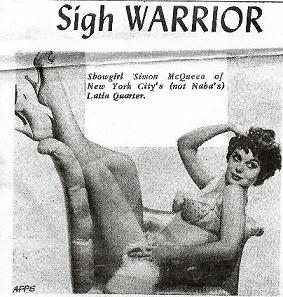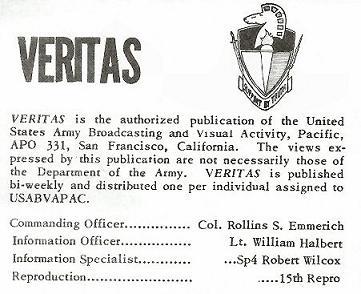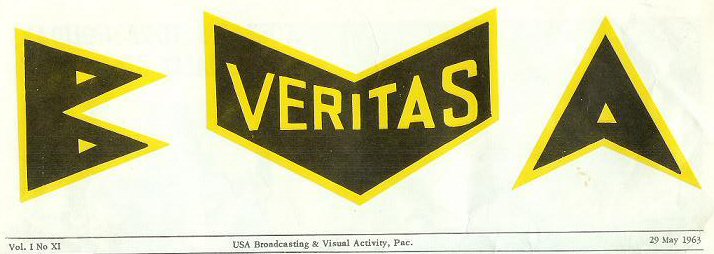HQ COMPANY 1961-62
Arrival and Assignment
It was either March or April 1961 that my friend Bill Usher and I arrived on Okinawa.. The trip had taken 27 hours by air from California to Hawaii, Wake Island, Tachikawa Japan and finally Okinawa.. Bill and I were posted to the 14th from Ft. Monmouth Signal School in the MOS of 270 Fixed Station Radio Attendant.. I enlisted in the Army in 1960 to train as a Radio Transmitter Repairman (MOS 272.1), but due to a SNAFU, ended up with the Radio Attendant Course.. Fortunately, through an upgrade exam after I arrived on Okinawa, I was able to change my MOS to Radio Repairman.. As a Ham Radio Operator (K8CTK at the time/WA3D now) I was more interested in servicing equipment than just turning dials and reading meters.. As it turned out, I did both and more in my approximately two year tour.
Bill was from North Carolina, but I lost track of him over the years and only recently found that he died of Aplastic Anemia in 1997. I included more information about Bill on "Where Are They Now Page." Every once in a while when I hear someone with a southern accent, I think of Bill Usher and remember an incident at the motor pool.. Bill and I were responsible for maintenance of several vehicles.. One day I asked if he had done any maintenance.. He replied that he had put "ALL" in the trucks.. "ALL"?? ..What is" ALL??" I responded.. He became very indignant and said "I put ALL in the trucks"....."OIL" he spelled.. "ALL".!
Our first assignment was to monitor radioteletype equipment in a communications compound about a quarter mile north of Hq..Our job was to keep these machines running and take the printed copy from various news agencies and other sources to the Research Division for use in broadcasts to mainland China, Korea and other asian countries.. We later moved to Deragawa where our duties changed and became much more interesting.. I no longer have close up pictures of the communications compound...One poor picture shows the general location from front of barracks.. .A picutre of me on roof of Barracks shows a better view of compound in the background.
Daily Life
Life at Headquarters Company was typical of Asian duty of the time.. We paid $7 a month to have an Okinawan house boy clean our shoes and brass and another Okinawan to take our KP duties.. This sounds incredible today but the base pay of a Pvt in 1961 was only about $80 a month. .The food in our mess was actually quite good and fortunately I saved a few holiday menus. Most of the officers brought their families to these holiday meals which added to the holiday spirit and made us briefly forget we were thousands of miles from home. Click on Image to enlarge and see content.
For those not working night duty, there was usually a brief company formation in the morning with less of the "Mickey Mouse" routine that usually occured with stateside duty.. Things did get "Chicken S_ _ t" later on. Depending on work schedules, our evenings and weekends were free.. Like most GI's on the Rock, typical off duty time was spent at church and ice cream socials.. Some of the men however, were known to visit local bars where young ladies were available to discuss the issues of the world.. I included a few ads for some of the better known night spots and other forms of entertainment from a 1961 copy of LIFE ON OKINAWA..
I remember that driving a vehicle on Okinawa was a trying experience. There were only 17 miles of paved highway at the time and any roads improved or not were used by the Okinawans for just about everything but driving a vehicle. We were required to take a "defensive driving course" before being allowed to drive any vehicle, military or civilian. We were told, "When you blow your horn, that does not mean get out of the way..." " That means, I see you." In spite of our "careful driving", Okinawa had one of the highest vehicle related fatality rates in Asia.....And woe be the GI who hit and killed a dog or horse. That would cost the GI from $50 to several thousand dollars.
Another daily problem on the island was the unexploded ordinance from WWII.. It seemed that on a weekly basis, an Okinawan child would be maimed or killed by playing with munitions they found. I can remember finding ordinance of many kinds by simply walking out on the reef at low tide. The first time I found an unexploded naval shell, I carried it ashore and reported it to a demolition unit that worked on a daily basis to deal with the left overs of war.. After a Marine sergeant told me I was an idiot for picking up the round, I just noted the location in the future.
Although we were called "PsyWarriors", a biweekly Bn publication Veritas also had a monthly "Sigh Warrior"
 |
 |
 |
Typhoons
The years have clouded my memory of many daily events but there were some I will never forget. .A few of these were the typhoons that seem to hit the island on a regular basis. .Just about every other week during the season we had alerts and were required to 'batten down the hatches". All items not anchored were moved indoors and canvas was removed from the vehicles.. When a typhoon did hit we were restricted to the barracks or at stations in the communications compound..Emergency generators were used to provide necessary power for essential equipment.
The "Big One" was Typhoon Nancy that devastated the island in 1962.. The highest sustained winds were 180 mph with gusts of 200.. Even though the windows in our reinforced concrete barracks were a strong casement design, some blew inward.. We saw first hand that the SOP to keep the windows open on the leeward side of the storm reduced the internal pressure and prevented the loss of more windows.. When the eye crossed the island we reversed the window closing since the winds shifted direction.. Fortunately no one was injured by inblown windows because we stayed between the windows during the height of the storm.. During the eye and after the winds abated we had to form a squeege bucket bragade to move the foot or more of water out of the building.. Excpet for a few vehicles being blown over and most being "sand blasted" by the wind, there was very little damage to our buildings and equipment.. The Okinawan villages surrounding Ft. Buckner did not fair as well since most of the buildings were of wood and bamboo construction..Many of the men volunteered to help clean up debris as well as distribute food and water..I often wonder what a storm of this magnitude would do to the U.S.
Cuban Missle Crisis
Since our unit was in the business of gathering information, it came as no surprise when the "stuff hit the fan" over Russian missles in Cuba.. We had been monitoring the situation for weeks and experienced more radio traffic than at any other time during my tour.. As a consequence we were on heightened alert.. .We were surprised when ordered to dig foxholes and prepare fortifications around the communications compound.. Everyone drew weapons and those not directly on duty had to stand watch at those fortifications.. At the time we thought this was overkill and joked about Cubans invading us with banana boats.. We latter found out that we were a heartbeat away from a war with Russia. . I still wonder how my M1 carbine would have done against a Russian Mig..... And yes we were still using WWII and Korean War vintage weapons. .The unit was not issued M14's (predecessor of M16) until 1963 shortly before I left the island.
SNAPSHOTS AND MORE AT MACHINATO
*Above 8mm clips were digitized and submitted by Glenn Kump. who served as Illustrator in Hq company from 1963-64. There is more about Glenn on Other Accounts Page
TDY To Korea
In orders dated 24 April 1962, five members of 16th Company including Bill Usher and I and four members of the 14th Hq company were temporarily assigned to the Korean PsyWar Unit.. Duty was specified as "Official PsyWar Activities" from 26 April 1962 to 26 May 1962..The following "Individuals Concerned" included:
- Lt. Ross Petzing
- SFC Benny Ostermiller
- Sp5 Stephan Guss
- Sp4 Richard Christian
- Sp4 Thomas Colt
- PFC Lyndell Fisher
- PFC William Usher
- PFC Tim Yoho
- PFC Hugh Martin
I saved the travel voucher that indicated i was allocated a grand total of $42.60 for the month based on what the Army would provde me.
| PER DIEM FOR: 30 DAYS @ $9.00 | $270.00 |
| 1 day @ $14.00 |
$ 14.00 |
TOTAL |
$284.00 |
LESS: 30 Qtrs @ 3.60 |
$108.00 |
1 Qtr @ $5.60 |
$ 5.60 |
90 meals @ $1.35 |
$ 121.50 |
3 meals @ $2.10 |
$ 6.30 |
Minus TOTAL |
$ 241.40 |
AMOUNT CLAIMED |
$ 42.60 I Wonder What These Numbers Would Be Today ! |
We did not take any vehicles or equipment on this assignment and were flown to Korea from Kadena to Tachikawa Japan and then on to Kimpo in Korea where we were taken by vehicle to the B&VA Hq located in Seoul.. I have only one surviving very poor B&W photo and one color shot of the B&VA compound. Both can be viewed in the photo section.. Some of our time was spent learning and using the radio broadcasting and monitoring equipment at the station. Daily radio broadcasts used the call sign VUNC or Voice of The United Nations Command.
The facilities were crude compared to our station on Okinawa.. Most of the equipment, barracks, and mess facilities were in Korean War vintage quonset huts..The huts were heated with oil heaters.. We joked about being treated like Marines since they still used quonset huts at many camps on Okinawa.. On our off duty time, we explored Seoul and learned more world events from the attractive Korean girls who worked at the many local libraries..The library services as well as all other goods and services were paid for with "Monopoly Money" or Military Payment Certificates. . We were not permitted to use U.S. currency in Korea or most other countries visited because of the black market in US dollars.. I saved some of this funny money including a 5 cent MPC .. We were also required to wear fatigue or "Class A" uniforms at all times since civilian clothes were not permitted. There was also a 12 midnight curfew for military as well as civilians.
We made a number of trips north to the DMZ to visit our AM broadcast stations (VUNC) and to record signal strength readings from our transmitters in Seoul and Okinawa. We traveled by jeep logging over 500 miles during several weeks.. These trips took about 8 hours and were no joy rides since all of the roads were dirt and some in very poor condition.. On one trip with a Sgt. Dudek (from Bellaire Ohio) we developed engine problems and had to limp into Camp Casey where we stayed a day until the engine was replaced (Photos Below).
One of the trips was to a transmitter site located on Kangwha-do island near the mouth of the Hon River as it flows into the Yellow Sea. a ferry was used to transport us to the island. I have lost pictures of the site but have one of the general area in "Pics" below.
On another trip, we traveled to the site of a new AM station under construction. .This site in the Chorwon Valley was the only American facility that close to the DMZ.. The closest American site nearby was an ASA compound a few miles away where we stayed over night for three days during our supervision of Transmitter site construction. . There were mine fields on either side of the road leading to the transmitter site and ROK tanks nearby.. I distinctly remember not being permitted to take pictures of the tanks, the point being made by an ROK soldier who pointed his weapon in my general vicinity and shook his head no.
Being so close to the DMZ We were required to have loaded weapons with us at all times; however, I never thought much of the firepower of an M-1 Carbine..... During one of the nights at the ASA unit we heard gun fire and learned a short while later that two North Korean infiltrators had been killed in a fire fight. One ROK soldier was wounded..
I learned from George Lane ( 9/10/04) that the Transmitter site was still in existence in 1970-71.. George, a civilian electronics engineer, worked as a consultant for the US government , and had visited this site when he was in Korea in 1970-71.
Bob Richards who served in KD (1960-61) indicated that during his tour they wore the 8th Army patch and not the Tori patch we we were wearing. Bob's e-mail underlined incidents that occurred to our TDY group... Several times Koreans spit at us as we walked by. We were told they spit at our "Japanese" Torii patch and not at us personally.
About the shoulder patches. You do know that in 1960, they made us at KD, stop wearing the Tori Patch and had to start wearing the 8th Army Patch. The front gate to KD was shaped like a Tori when I arrived there in January 1960. The gate came down and patch removed at the request of the Korean Govt. It was a symbol of their capitivity of the Japanese. And they were required to worship at the Torii shaped shrines all over Korea. I had a photo made of me with the patch showing so I could have a memory of it. I think, someone told me that later on after 1961 that they starting wearing the Tori again, dont know if true or not.
Bob
Our group returned to the "Rock" at the end of May 1962 to find some "new guys" including PFC's Jay Eubanks and Steve Southerland who would become my very good friends...
Also see Korea History
KOREA SNAPSHOTS
| War Damage Still Remains |
| Korean War Graves? |
| Rice Paddies Near B&VA Site at Hon River |
| Front Gate of KD (contributed by Bob Richards) |
| KD BVA VUNC Sign and Compound (Bob Richards) |
| PFC Forrest, Pvt Drury, PFC Kennedy in Compound (Bob Richards) |
| PFC's Kennedy & Forrest in front Signal Shop (Bob Richards) |
| Bob Richards with Mop |
|